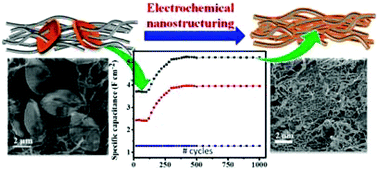Our official English website, www.x-mol.net, welcomes your feedback! (Note: you will need to create a separate account there.)
Electrochemical, top-down nanostructured pseudocapacitive electrodes for enhanced specific capacitance and cycling efficiency†
Nanoscale ( IF 6.7 ) Pub Date : 2018-01-23 00:00:00 , DOI: 10.1039/c7nr08164b Vishwanath Kalyani 1, 2, 3, 4 , Sudeshna Mondal 1, 2, 3, 4 , Jayeeta Saha 1, 2, 3, 4 , Chandramouli Subramaniam 1, 2, 3, 4
Nanoscale ( IF 6.7 ) Pub Date : 2018-01-23 00:00:00 , DOI: 10.1039/c7nr08164b Vishwanath Kalyani 1, 2, 3, 4 , Sudeshna Mondal 1, 2, 3, 4 , Jayeeta Saha 1, 2, 3, 4 , Chandramouli Subramaniam 1, 2, 3, 4
Affiliation

|
Stabilization of the electroactive redox centers on ideally polarisable conductive electrodes is a critical challenge for realizing stable, high performing pseudocapacitive energy storage devices. Here, we report a top-down, electrochemical nanostructuring route based on voltammetric cycling to stabilize β-MnO2 on a single walled carbon nanotube (CNT) scaffold from a MnMoO4 precursor. Such in situ nanostructuring results in controlled disintegration of an ∼8 μm almond like structure to form ∼29 nm β-MnO2 resulting in a 59% increase in the specific surface area and a 31% increase in the porosity of the pseudocapacitive electrode. Consequently, the specific capacitance and areal capacitance increase by ∼75% and ∼40%, respectively. Such controlled, top-down nanostructuring is confirmed through binding energy changes to Mo 3d, C 1s, O 1s and Mn 2p respectively in XPS. Furthermore, Raman spectral mapping confirms the sequential nanostructuring initiating from the interface of CNTs with MnMoO4 and proceeding outwards. Thus, the process yields the final CNT/β-MnO2 electrode that is electrically conductive, facilitates rapid charge transfer, and has increased capacitance and longer stability. Furthermore, the charge-transfer resistance and equivalent resistance are significantly lower compared to conventional activated carbon based electrodes.
中文翻译:

自上而下的电化学纳米结构伪电容电极,可提高比电容和循环效率†
为了实现稳定的,高性能的伪电容储能装置,电活性氧化还原中心要稳定在理想的可极化导电电极上,这是一个关键的挑战。这里,我们报告基于伏安循环自上而下,电化学纳米结构化的路线,以稳定β-MnO的2上从MnMoO一个单壁碳纳米管(CNT)的支架4前体。这种原位在〜8微米杏仁状结构的受控崩解纳米结构的结果,以形成〜29纳米的β-MnO的2导致比表面积增加59%,伪电容电极的孔隙率增加31%。因此,比电容和面电容分别增加了约75%和约40%。通过在XPS中分别改变对Mo 3d,C 1s,O 1s和Mn 2p的结合能变化,可以确认这种受控的,自上而下的纳米结构。此外,拉曼光谱图证实了从CNT与MnMoO 4的界面开始并向外进行的连续纳米结构。因此,该方法产生最终的CNT /β-MnO的2导电的电极,有助于快速的电荷转移,并具有增加的电容和更长的稳定性。此外,与传统的基于活性炭的电极相比,电荷转移电阻和等效电阻明显更低。
更新日期:2018-01-23
中文翻译:

自上而下的电化学纳米结构伪电容电极,可提高比电容和循环效率†
为了实现稳定的,高性能的伪电容储能装置,电活性氧化还原中心要稳定在理想的可极化导电电极上,这是一个关键的挑战。这里,我们报告基于伏安循环自上而下,电化学纳米结构化的路线,以稳定β-MnO的2上从MnMoO一个单壁碳纳米管(CNT)的支架4前体。这种原位在〜8微米杏仁状结构的受控崩解纳米结构的结果,以形成〜29纳米的β-MnO的2导致比表面积增加59%,伪电容电极的孔隙率增加31%。因此,比电容和面电容分别增加了约75%和约40%。通过在XPS中分别改变对Mo 3d,C 1s,O 1s和Mn 2p的结合能变化,可以确认这种受控的,自上而下的纳米结构。此外,拉曼光谱图证实了从CNT与MnMoO 4的界面开始并向外进行的连续纳米结构。因此,该方法产生最终的CNT /β-MnO的2导电的电极,有助于快速的电荷转移,并具有增加的电容和更长的稳定性。此外,与传统的基于活性炭的电极相比,电荷转移电阻和等效电阻明显更低。



























 京公网安备 11010802027423号
京公网安备 11010802027423号